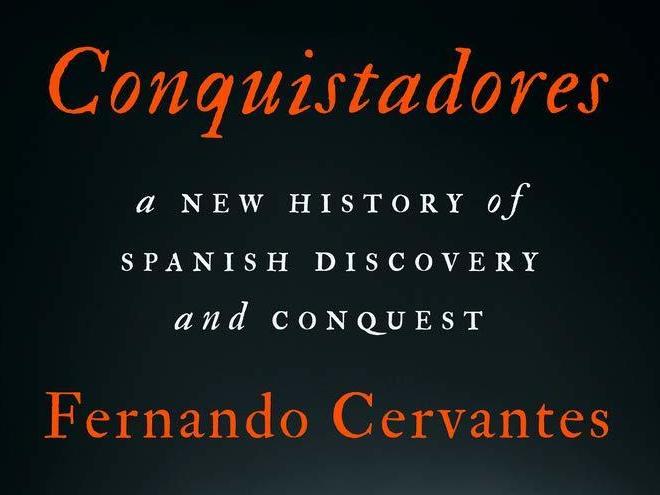Section Branding
Header Content
Atrocities Of 'Conquistadores' Take Shape In New History By Mexican-Born Author
Primary Content
When the Spanish conquistador Hernán Cortés and his band of 300 men reached the Aztec capital of Tenochtitlan in late 1519, they found a civilization of staggering beauty that dwarfed any western European city.
Stucco towers, "painted with colorful animals and sculpted on stone" were "a marvel to behold," drawing comparisons to Venice, one observer wrote. Tens of thousands of canoes dotted Lake Texcoco, "some, like great barges, carrying up to sixty people," writes Fernando Cervantes in Conquistadores, his masterful new history of the era.
Cortés was greeted by the Aztec emperor Moctezuma who "appeared on a litter, borne by noblemen, with a baldachin of green feathers, fitted with jade and beautifully adorned with gold and silver embroidery." But Moctezuma himself was said to be filled with "sickening dread" over the Spaniards' arrival, and his fears would prove prescient. The Aztec city's fate was already sealed.
When Cortés departed on another expedition, he temporarily left Tenochtitlan in the hands of his deputy, Pedro de Alvarado, who had "none of Cortés's political skills, and all the prickly honour of a chivalrous knight," Cervantes writes. Finding themselves surrounded by dancers during a festival, Alvarado and his men suspected an attack was imminent and decided to strike first. In the ensuing massacre, wrote one informant, "The blood ... ran like water, it spread out slippery and a foul odor rose from it." The war that followed ultimately left the great city of Tenochtitlan in ruins.
A Mexican-born historian who now teaches at the University of Bristol in England, Cervantes marshals an enormous array of primary and secondary sources to tell the story of the decades that followed Christopher Columbus' arrival on an island off what is now Cuba, in "three cramped, ill- equipped vessels, with a combined capacity of ninety men."
Columbus had spent years trying to persuade Spain's rulers that he could find a western sea route to Asia and believed until his dying day that he had succeeded. What he achieved was arguably much more consequential: His voyage would kick off a "flurry of expeditions" aimed at plundering the wealth of the New World and, in the process, subjugating its indigenous populations, capped off by the bloody conquest of two great civilizations: The Aztecs of Mexico and the Incas of Peru.
Away from home for months at a time and separated by a vast ocean, the conquistadors who led these expeditions could act with a great deal of independence, if not impunity, and they would subdue and transform the New World with dizzying speed. "These vast, newly acquired territories quickly began to bear the marks of their energetic and often rapacious settlers," Cervantes writes. Monasteries, palaces, mansions and commercial enterprises "soon dominated the landscape," sending a message that the Spaniards were there to stay.
There's a depressing sameness to the way Cervantes tells the story. The indigenous populations sometimes fought back, often with great skill and courage, and could themselves be brutal to their enemies. But they were ultimately no match for the Europeans, who came in greater and greater numbers and carried artillery that seemed to give them God-like powers. And what to make of the horses they rode? "...To a group of people who had never seen such animals — and who saw them mounted by men who seemed inseparably fused to them — it was a terrifying experience." Cervantes writes.
For their part, Europeans viewed the people of the New World with a combination of fear and awe, but also as subjects of the Spanish crown — to be converted to Christianity whether they liked it or not, as Cervantes details. Although they were almost always outnumbered by the natives, the Spaniards were skilled at forming alliances, exploiting local rivalries by playing one indigenous group against another. What followed was a culture clash of epic brutality.
Cervantes sets out not to whitewash such atrocities but to place them in context. Modern historans like to emphasize the genocide and greed that's undeniably part of the legacy of the conquistadors, but as Cervantes reminds us, that wasn't always the case. In Spain at the time, "the most honored members of society were those who had won their riches by force of arms," and plunder was seen as a "legitimate means to wealth." Far from being condemned, early explorers such as Cortés and Francisco Pizarro were celebrated for their daring and bravery, in Spain and elsewhere. There was a swashbuckling romance to their stories.
That began to change as tales of violence and brutality made it back to Europe, leading here and there to bouts of soul-searching. Many people were appalled when Pizarro, eager to get back to gold-hunting, decided to execute the imprisoned Incan emperor Atawallpa to neutralize him as a threat. In 1526, the Council of the Indies complained that too many Spaniards were treating the natives "far worse than if they were slaves" (who were themselves already being brought into the New World), Cervantes writes. They had caused the deaths of "a large number of the said Indians on a scale that has turned many of the islands and large swathes of the mainland into veritable wastelands, bereft of population." There were practical considerations: How could you convert the natives to Christianity if they were dead? But Spain's rulers, mired in an endless series of costly religious wars, needed the gold and other treasures being imported from the New World and often chose to overlook what was happening.
Cervantes argues that some aspects of life after the Spanish conquest should be reexamined. He expresses qualified admiration for the network of mendicant friars who, disobeying Rome, learned to fuse Catholic teaching with native religious rites in a way that enabled Christianity to take root in the New World. He also says that the system of governance Spain put in place proved more popular and resilient than commonly believed. It was built not around the modern conception of nation states but around indigenous "kingdoms" allowed to operate autonomously under "the legitimizing aegis of the monarchy."
While it doesn't change the fact that the conquest was brutal, it's history that's easy to lose sight of when considered alongside the long, bloody history that precedes it, Cervantes contends. Within a few years, the conquistadors had fallen out of favor, and day-to-day control of the New World had been transferred to a less romantic but more enduring figure: The government bureaucrat.
Copyright 2021 NPR. To see more, visit https://www.npr.org.
Bottom Content




